Game Fishing target species
Game Fishing - Light & Heavy Tackle/ Popper Fishing
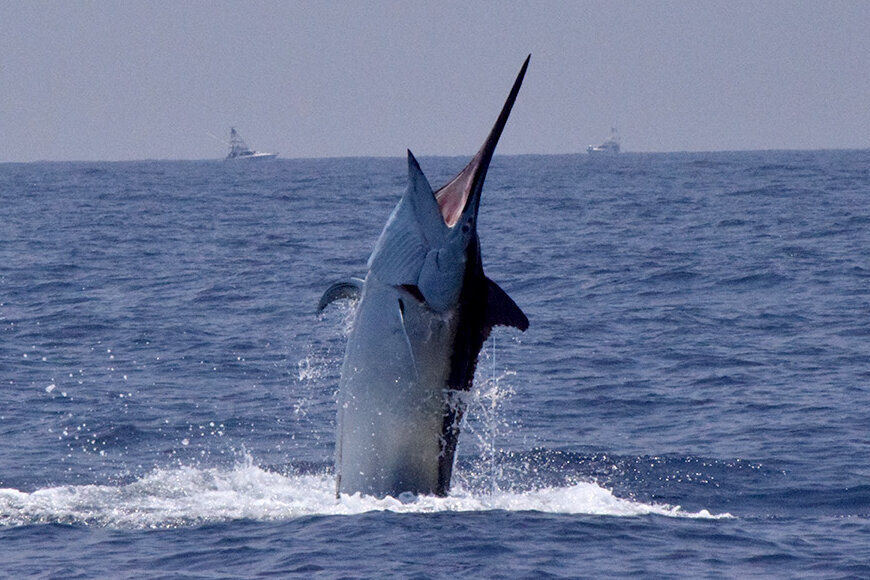
Did you know?
- 85% of the world's 1000lb+ marlin are caught on local grounds of the Great Barrier Reef
- Sep - Dec: females arrive from the Pacific Ocean
- Port Douglas has the quickest access - 30 miles from the coast
- Extreme dynamic fighting capabilities
- Offer surging runs at lightning speed
- Launch into the air
- 80lb-130lb reels are used for largest size
- Fights average 15-30 min but can last several hours
- Marlin are released
Marlin
We pay homage to the Black and Blue Marlin and boast the best marlin grounds in the world. Statistically 85% of the world's 1000lb plus fish are caught on our local grounds of the Great Barrier Reef. From all corners of the globe anglers arrive on our doorstep to achieve what many consider as the Holy Grail of Fishing.
During the months of September to December the bigger females arrive from the Pacific Ocean to breed with our smaller male stallions which reside all year round. This congregation occurs on the edge of the continental shelf adjacent to our outer reef systems only 30 miles from the coast. Port Douglas has the quickest access to these grounds anywhere along the east coast.
The use of game vessels is paramount to handle the furious pace of this fishing once hooked-up to a marlin. They are extremely strong and have extremely dynamic fighting capabilities launching into the air and offer surging runs at lightning speed.
With modern technology many fights average 15-30 minutes in length but many have been known to last several hours. 80lb-130lb reels are used to tame these beauties during the breeding season and 30lb-50lb stand-up tackle is used outside of this for the smaller resident models. Trolling big skip baits is the industry standard for the bigger fish but they also are caught on game fishing skirted lures and garfish rigs (more so the smaller male species and blue marlin).
An experienced specialised crew is essential to be successful at this pursuit because it's claimed as the pinnacle of fishing achievements. It's Formula One Grand Prix Fishing and simply a pure adrenalin rush you'll never forget.
Marlin are released as standard industry practice.
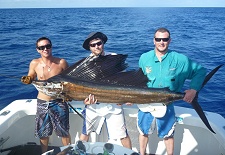
Did you know?
- Sizes vary up to 100kg
- Appear all year round, increased numbers during the warmer months
- Show up for a month or two after Marlin breeding season ends
- Beautiful visual display on the surface
- Sailfish are released
Sailfish
We are blessed to have a resident population of these fish on our local grounds all year round. They do however appear in better numbers during the warmer months and become an awesome by-catch to the marlin. Once the marlin breeding season switches off these classic fish continue to show up for a month or two later on the same grounds.
They are awesome sport on 30lb-50lb stand up gear and offer a visual display on the surface like no other. They will take game skirted lures and garfish rigs. The photos taken of your catch onboard are nothing short of spectacular and leave you with long life memories. Fish sizes vary up to 100kg.
Sailfish are released as standard industry practice.

Did you know?
- Species include yellowfin tuna and dogtooth tuna
- Common throughout the year but increased numbers during the warmer months
- Work in schools resulting in multiple hook-ups
- Methods are trolling, jigging and spin casting
- Part of the light and heavy game fishing process
- Very worthy catch to keep and consume
- Ideal for sashimi dishes
Tuna
Our outer reef systems and the continental shelf offer an array of tuna species including yellowfin tuna and dogtooth tuna as the preferred species. At anytime of the year we can produce these powerful fish with the warmer months peaking. They work in schools rounding up baitfish and multiple hook-ups are common.
A variety of methods are employed to catch these fish including trolling, jigging and spin casting. They offer tremendous angling opportunities with powerful runs and models can range up to 40kg plus. They are all part of the light and heavy game fishing process and add to the spectacle on the Great Barrier Reef.
Tuna are considered a very worthy catch to keep and consume and ideal for sashimi dishes.
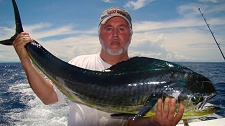
Did you know?
- Known as Mahi Mahi or El Dorado
- Appears in fresh currents of the continental shelf and outer reef edges during the warmer months
- Can grow up to 20kg in only 4 years of living
- Hunt in packs
- Caught using light tackle game fishing methods with a variety of lures
- Stunning skin exhibits transforming gold, green, lime, purple and aqua colours
- Excellent to keep and consume
Dolphin Fish
Also known as El Dorado and Mahi Mahi. A classic fish which appears on the fresh currents of the continental shelf and outer reef edges during the warmer months. These fish party hard and die young but can grow up to 20kg in only 4 years of living.
They are part of the package which arrives along with an array of pelagic species and are considered highly as a sporting fish. They tend to hunt in packs searching for their quarry and once hooked they will parade mostly on the surface.
Once in the boat their ever changing colours are the best in the angling world as their skin exhibits transforming gold, green, lime, purple and aqua colours. They are often caught when targeting tuna and Spanish mackerel/ wahoo using light tackle game fishing methods attacking a variety of lures.
Dolphin fish are considered an excellent quarry to keep and consume. Minimum size - 50cm.

- Appear on the continental shelf edge
- Larger numbers later in the year from Oct - Jan
- Ultimate speedsters of the ocean
- Caught using stand-up light game fishing gear
- Attack a variety of lures but best high speed skirted lure trolled at around 6-8 knots
- Found in schools
- Can reach up to 40kg
- Top rated species to keep and consume
Wahoo
These fish are the ultimate speedsters of the ocean hitting lures at incredible speeds. We see them at their peak later in the year in big numbers from October - January on the continental shelf edge and are mostly caught using stand-up light game fishing gear. They will attack a variety of lures but can't resist a high speed skirted lure trolled at around 6-8 knots.
Once hooked they offer blistering runs one after the other and are a formidable catch. They are often found in schools and multiple hook-ups are very common once you've run across these fish. They can reach up to 40kg.
Wahoo are considered as a top rated species to keep and consume. Minimum size - 75cm.
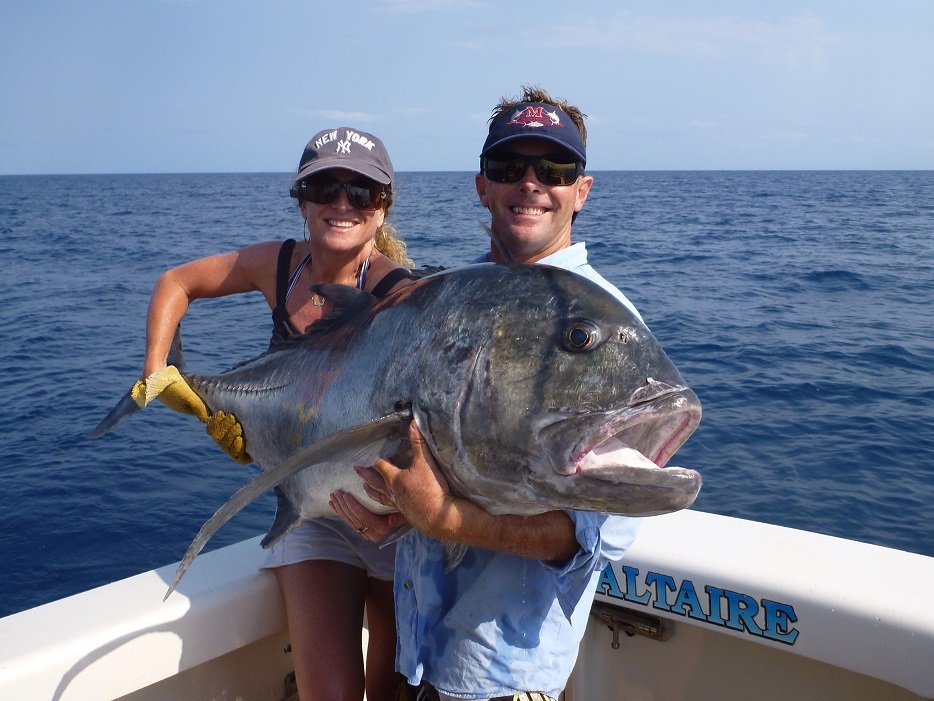
- Found in abundance around reef edges
- Best caught using high quality spinning rods and blooping large popper lures
- Are incredible powerful
- Hardest fighting fish on the planet
- Have earned the reputation as the 'thugs of the sea'
- Pure sport and trophy fish
- Giant Trevally is released
Giant Trevally
Our Great Barrier Reef system is riddled with these ultimate light tackle adversaries. Using high quality spinning rods and blooping large popper lures across the surface is the best tactic to attract the attention of a giant trevally. Sourcing bait schools which are nervously twitching on the surface along the reef edges often will often have a Giant Trevally hovering nearby. The popper action resembles an injured baitfish and consequently will be ambushed.
Once hooked Giant Trevally's pound for pound are arguably the hardest fighting fish on the planet. They fight hard and dirty, have incredible power and have earned the reputation as the 'thugs of the sea'.
Anglers and tackle are tested to the absolute limit and thus the Giant Trevally is a trophy fish. Being a pure sportfish they are released upon capture.
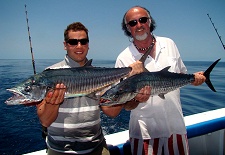
- Appear all year round but increased numbers during cooler months
- Related to Wahoo and built for speed
- Fight with pulsating vigour
- Found in large schools
- Can grow up to 40kg
- Very popular sporting fish to target
- Extremely appreciated because of its beautiful firm flesh and flavour
Spanish Mackerel
Closely related to the wahoo species these fish are built for speed and are found along our entire Great Barrier Reef system and along the continental shelf. Trolling a variety of lures or rigged garfish these fish hit at lightning speed and offer a series of blistering runs. They fight with pulsating vigour all the way to the boat and are your classical light game fish using 8-15kg class line.
Often they will be found in large schools as they collectively herd up bait schools on the surface. They patrol the deep reef edges and open grounds and can grow to 40kg. They are a very popular species to target and are a highly regarded sporting fish. They can be caught all year round but turn up in larger numbers in the cooler months.
Spanish mackerel have a beautiful firm flesh and their flavour is extremely widely appreciated. Minimum size - 75cm.


